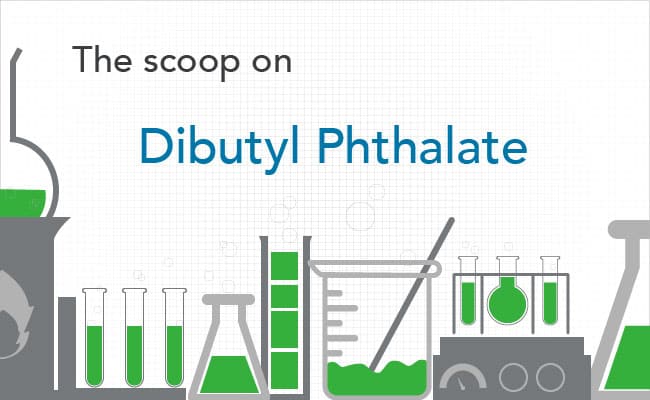
What is dibutyl phthalate?
Dibutyl phthalate is a synthetically produced chemical used in fragrances as well as a plasticizer and a solvent [1] [2]. It is oily, odorless, and colorless and it is used to make plastics more flexible as well as to add desirable qualities to insect repellents, hair sprays, and nail polish [2].
What is products is dibutyl phthalate in?
Dibutyl phthalate is in a variety of personal care products like hair spray, insect repellent, and nail polish [2]. It is also used in some household cleaning products, plastics, glues, paints, and rocket fule [3].
How to tell if a product has dibutyl phthalate
Dibutyl phthalate may be listed under a number of different ingredient names including: 1,2 benzenedicarboxylic acid, dbp (ester), dibutyl ester, butyl phthalate, 1,2-benzenedicarboxylate, DBP, dibutyl ester 1,2-benzendicarboxylic acid, dibutyl phthalates, benzene-o-dicarboxylic acid di-n-butyl ester, celluflex dpb, di-n-butylphthalate, dibutyl [1]. Because it’s also used as a fragrance ingredient and fragrances are considered to be “trade secrets“, it can be difficult to know which fragranced products it is in.
Risks associated with dibutyl phthalate
The European Commission has banned the use of dibutyl phthalate in personal care products and cosmetics and the State of California has classified it as a developmental and reproductive toxicant [1]. Health issues that can result from fetal exposure to dibutyl phthalate during pregnancy include:
- Infertility
- Cryptorchidism
- Sperm development problems
- Effects similar to human testicular dysgenesis syndrome
- Anatomical changes in the reproductive development of baby boys [1] [3]
Adult men who are exposed to dibutyl phthalate may experience changes in their serum hormone levels resulting in a lower sperm count, diminished sperm motility, and decreased fertility [1].
How to avoid dibutyl phthalate:
You can avoid dibutyl phthalate by reading product labels on household cleaners, personal care products, and cosmetics. Also be aware that this ingredient may be in some children’s toys [3]. Avoid all products that contain 1,2 benzenedicarboxylic acid, dbp (ester), dibutyl ester, butyl phthalate, 1,2-benzenedicarboxylate, DBP, dibutyl ester 1,2-benzendicarboxylic acid, dibutyl phthalates, benzene-o-dicarboxylic acid di-n-butyl ester, celluflex dpb, di-n-butylphthalate, or dibutyl [1]. In cleaning products, where manufacturers aren’t required to list all their ingredients on product labels, choose toxic chemical free alternatives with safe natural ingredients. Also remember that there are no federal criteria dictating standards for what makes something a “natural” cleaner, so avoid cleaners with fragrances.
References:
[1] EWG’s Skin Deep Cosmetics Database (2007-2016). Dibutyle phthalate. Available online: https://www.ewg.org/skindeep/ingredient/701929/DIBUTYL_PHTHALATE/ December 8, 2016.
[2] Agency for Toxic Substances and Disease Registry (2011). Di-n-butyl Phthalate. Available online: https://www.atsdr.cdc.gov/substances/toxsubstance.asp?toxid=167 December 8, 2016.
[3] Agency for Toxic Substances and Disease Registry (). ToxFAQ’s for Di-n-buytl Phthalate. Available online: https://www.atsdr.cdc.gov/toxfaqs/tf.asp?id=858&tid=167 December 8, 2016.



